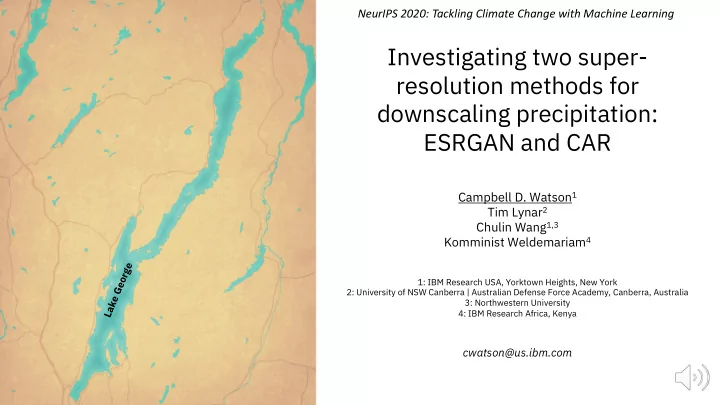

NeurIPS 2020: Tackling Climate Change with Machine Learning Investigating two super- resolution methods for downscaling precipitation: ESRGAN and CAR Campbell D. Watson 1 Tim Lynar 2 Chulin Wang 1,3 Komminist Weldemariam 4 Lake George 1: IBM Research USA, Yorktown Heights, New York 2: University of NSW Canberra | Australian Defense Force Academy, Canberra, Australia 3: Northwestern University 4: IBM Research Africa, Kenya cwatson@us.ibm.com
The Jefferson Project at Lake George Multi-year partnership initiated in June 2013 | Understand and manage the complex factors threatening Lake George Monitor, model, predict and experiment | 60+ scientists and engineers Operational Forecasting System Weather Observing Cyberinfrastructure Land and Lake Circulation Hydrology
cwatson@us.ibm.com
What weather model resolution is sufficient for medium-sized lakes and smaller? 6 km grid 15 km grid GFS Model: 13 km HRRR Model: 3 km (18 hrs) NAM Model: 12 km RAP Model: 13 km
Operational Weather Forecasts at Lake George WRF/WRFDA v3.9.1 Four one-way nested domains : 9 / 3 / 1 / 0.33 km Daily, operational forecasts of 36 hrs duration Each forecast takes ~6 hrs on 160 cores --> Can super-resolution help? Over 3 years of daily forecasts at 0.33 km resolution Aim: Reconstruct the WRF-simulated precip at 1 km resolution from the 9 & 3 km precip with efficient ML Figure 1: WRF model domains in northeast USA (Lake George is outlined in red). This manuscript uses WRF data from the three outer domains with 9, 3 and 1 km grid resolution.
Motivation i) Reduce the use of energy-intensive weather simulations ii) Create ensembles of weather forecasts for uncertainty quantification ii) Scale global, high res weather & climate predictions without continuing need for huge supercomputers Researchers have been exploring machine learning techniques downscale coarser resolution weather and climate simulations to finer resolution grids…. Regression based methods Analog methods Auto-regression methods Deep neural network super-resolution based methods <-- Focus of this work N A G R S E
ESRGAN CAR Content adaptive-resampler for image-based Enhanced super-resolution generative downscaling by Sun and Chen [2020] adversarial networks by Wang et al. [2019] The resampler network generates content A deep neural network approach initially adaptive image resampling kernels which are created for use with natural images which applied to the original high-resolution input to typically have no inherent resolution generate pixels on the downscaled image Manepalli et al. [2020] used ESRGAN to Used the default configurations as proposed by reproduce the simulated power spectral Sun and Chen [2020] density of near-surface winds at 2x resolution We employed the SRResNet structure with the Residual-in-Residual Dense Block as basic blocks TWO EXPERIMENTS Removed VGG and GAN loss to optimize for the EXP 1: Feature values are 3 km WRF variables; target variable prediction accuracy rather than visual quality is 1 km WRF precipitation (3x downscaling) (as suggested by Wang et al. 2019) EXP 2: Feature values are 9 km WRF variables; target variable is 1 km WRF precipitation (9x downscaling)
Figure 2: Example of precipitation reconstructions by the ESRGAN and CAR models from 9 km to 1 km horizontal resolution. The panels show accumulated precipitation (mm/hr) in the hour preceding 2019-11-01 04:00 UTC. (a) Original WRF precipitation from the 9 km domain; (b) original WRF precipitation from the 1 km domain (target); reconstruction by ESRGAN to 1 km resolution; and (d) reconstruction by the CAR model to 1 km resolution Table 1: Mean absolute error using Bicubic, ESRGAN and CAR methods. The output grid resolution is 1 km, and the input grid resolution is listed in the table. The ESRGAN model has the best performance, followed by the CAR model. Both of the proposed models outperform the baseline bicubic interpolation. EXP 1 EXP 2
ONGOING THOUGHTS… Expand analysis to include additional variables , specifically near surface winds, surface humidity and downward short and long wave radiation. These are key inputs to hydrodynamic models. Apply ESRGAN to downscale GFS data from 25 km resolution to the 1 km WRF domain . This is a particularly demanding task given the GFS model has different model parameterizations and dynamical core. How transferable and generalizable is this approach? Manepalli et al. [2020] showed some success in this regard using ESRGAN to downscale winds, and is key to moving to climatic geographies. How much data is required to adequately train the model? Here, we provided over nearly 2.5 years of hourly data for training – a prohibitive amount of simulation for larger geographic areas.
Recommend
More recommend